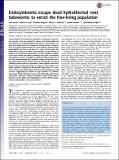| dc.contributor.author | Klose, Julia | |
| dc.contributor.author | Wagner, Michael | |
| dc.contributor.author | Schimak, Mario P. | |
| dc.contributor.author | Gollner, Sabine | |
| dc.contributor.author | Bright, Monika | |
| dc.contributor.author | Polz, Martin F | |
| dc.date.accessioned | 2016-04-04T16:04:54Z | |
| dc.date.available | 2016-04-04T16:04:54Z | |
| dc.date.issued | 2015-09 | |
| dc.date.submitted | 2015-01 | |
| dc.identifier.issn | 0027-8424 | |
| dc.identifier.issn | 1091-6490 | |
| dc.identifier.uri | http://hdl.handle.net/1721.1/102104 | |
| dc.description.abstract | Theory predicts that horizontal acquisition of symbionts by plants and animals must be coupled to release and limited dispersal of symbionts for intergenerational persistence of mutualisms. For deep-sea hydrothermal vent tubeworms (Vestimentifera, Siboglinidae), it has been demonstrated that a few symbiotic bacteria infect aposymbiotic host larvae and grow in a newly formed organ, the trophosome. However, whether viable symbionts can be released to augment environmental populations has been doubtful, because (i) the adult worms lack obvious openings and (ii) the vast majority of symbionts has been regarded as terminally differentiated. Here we show experimentally that symbionts rapidly escape their hosts upon death and recruit to surfaces where they proliferate. Estimating symbiont release from our experiments taken together with well-known tubeworm density ranges, we suggest a few million to 1.5 billion symbionts seeding the environment upon death of a tubeworm clump. In situ observations show that such clumps have rapid turnover, suggesting that release of large numbers of symbionts may ensure effective dispersal to new sites followed by active larval colonization. Moreover, release of symbionts might enable adaptations that evolve within host individuals to spread within host populations and possibly to new environments. | en_US |
| dc.language.iso | en_US | |
| dc.publisher | National Academy of Sciences (U.S.) | en_US |
| dc.relation.isversionof | http://dx.doi.org/10.1073/pnas.1501160112 | en_US |
| dc.rights | Article is made available in accordance with the publisher's policy and may be subject to US copyright law. Please refer to the publisher's site for terms of use. | en_US |
| dc.source | National Academy of Sciences (U.S.) | en_US |
| dc.title | Endosymbionts escape dead hydrothermal vent tubeworms to enrich the free-living population | en_US |
| dc.type | Article | en_US |
| dc.identifier.citation | Klose, Julia, Martin F. Polz, Michael Wagner, Mario P. Schimak, Sabine Gollner, and Monika Bright. “Endosymbionts Escape Dead Hydrothermal Vent Tubeworms to Enrich the Free-Living Population.” Proc Natl Acad Sci USA 112, no. 36 (August 17, 2015): 11300–11305. | en_US |
| dc.contributor.department | Massachusetts Institute of Technology. Department of Civil and Environmental Engineering | en_US |
| dc.contributor.department | Parsons Laboratory for Environmental Science and Engineering (Massachusetts Institute of Technology) | en_US |
| dc.contributor.mitauthor | Polz, Martin F. | en_US |
| dc.relation.journal | Proceedings of the National Academy of Sciences | en_US |
| dc.eprint.version | Final published version | en_US |
| dc.type.uri | http://purl.org/eprint/type/JournalArticle | en_US |
| eprint.status | http://purl.org/eprint/status/PeerReviewed | en_US |
| dspace.orderedauthors | Klose, Julia; Polz, Martin F.; Wagner, Michael; Schimak, Mario P.; Gollner, Sabine; Bright, Monika | en_US |
| dc.identifier.orcid | https://orcid.org/0000-0001-9296-3733 | |
| mit.license | PUBLISHER_POLICY | en_US |
